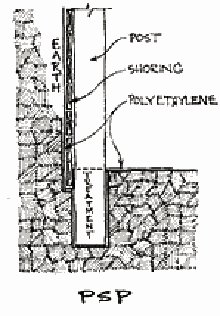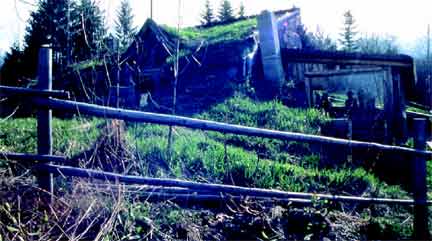
Waterproofing the underground house
 The outer skin of Oehler's
houses is a layer of polyethylene which is used as a moisture barrier
to keep the walls from rotting. Initially, he was using 4 to 6
mil plastic, but had upped that thickness to 6 to 10 mil by the time he
wrote his book about greenhouses, and noted that he's now using EPDM
pond liners for one of the two roof layers.
The outer skin of Oehler's
houses is a layer of polyethylene which is used as a moisture barrier
to keep the walls from rotting. Initially, he was using 4 to 6
mil plastic, but had upped that thickness to 6 to 10 mil by the time he
wrote his book about greenhouses, and noted that he's now using EPDM
pond liners for one of the two roof layers.
After making the
framework of the house out of posts and beams, Oehler digs another narrow
trench behind the walls and layers mill-ends (or other cheap boards)
against the outside of the posts. The plastic goes directly
outside the mill-ends, and the whole wall is held together by the force
of the earth rather than by any fasteners.
The roof gets a bit more
fancy treatment, starting with a layer of building paper and
polyethylene, covered by four inches of earth, another layer of
plastic, then fourteen more inches of earth. Eventually, plants
will take hold there  and create a living roof.
and create a living roof.
While a thin layer of
plastic doesn't seem like much to keep an underground house dry, the
design seems to be working, at least in Oehler's location. As he
points out in his book, you have to take his system as a whole rather
than pick and choose if you want it to work --- presumably polyethylene
wouldn't be enough to keep water out if you didn't plan the entire
structure so water's always flowing away from the walls.
Stay tuned for another
lunchtime series soon about his followup book, covering earth-sheltered
greenhouses.
| This post is part of our The $50 and Up Underground House Book
lunchtime series.
Read all of the entries: |
Want more in-depth information? Browse through our books.
Or explore more posts by date or by subject.
About us: Anna Hess and Mark Hamilton spent over a decade living self-sufficiently in the mountains of Virginia before moving north to start over from scratch in the foothills of Ohio. They've experimented with permaculture, no-till gardening, trailersteading, home-based microbusinesses and much more, writing about their adventures in both blogs and books.
Want to be notified when new comments are posted on this page? Click on the RSS button after you add a comment to subscribe to the comment feed, or simply check the box beside "email replies to me" while writing your comment.

I have been reading all of the posts about Oehler's theory on building below ground. I also know of a bunch of companies that are going a different direction with underground structures, and building earthships. I also know of the though of building up the ground to the structure, instead of sinking it in, so it is less likely to retain water and a few other advantages. Now assuming that we are smart and build our structure below the highest point on our property, for water catchment and gravity distribution, which direction do you think you would go with the structure? Also, if I remember correctly, you have a roof build above your trailer to get the sun off and allows ventilation to keep hot air away as well. Do you think it would be a cool idea to have one above an earth structure? "Check out my Survivalist Blog at the Clever Survivalist and read daily Survival Guide content."
PE can resist a whole lot of very aggresive substances pretty well. Peroxides (30%) and acetone are often sold in PE containers. You'd need nasty solvents to dissolve it. So it does not easily biodegrade (without the help of UV).
Ultraviolet light is the bane of all plastics, because its photons have enough energy to break the chemical bonds in the plastic. So if it's not exposed to sunlight it could last a long time.
Investigations done in Austria and in the US on water and gas pipes that had been buried for 30 years found that they were still in very good condition. For modern PE pipes lieftimes of 50 years are taken for granted and 100 years is seen as possible.
So at a guess I'd say that even PE foil should be able to several decades.
However, a thin film could relatively easily be pierced by stones, roots and possibly burrowing animals.